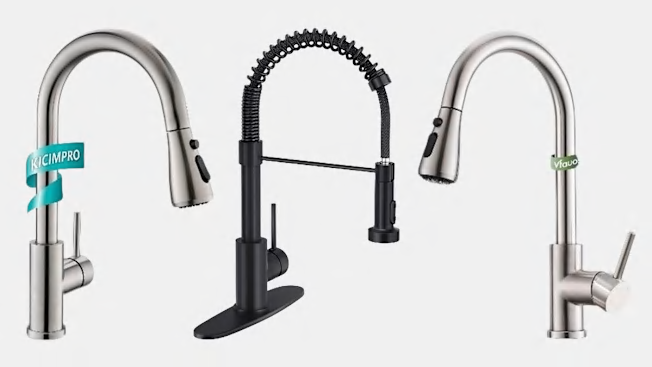Stop Using Dangerous Faucets, Regulator Warns
More than 100,000 of the Chinese-made faucets sold on Amazon pose lead-exposure risks to young children and pregnant women
When you shop through retailer links on our site, we may earn affiliate commissions. 100% of the fees we collect are used to support our nonprofit mission. Learn more.

The Consumer Product Safety Commission is warning of dangerous lead levels associated with certain Chinese-made faucets sold online and is advising consumers to double-check that any faucet they buy meets U.S. safety standards.
Last week the agency announced the recall of 100,000 kitchen faucets sold under the names Basdehen, Kicimpro, and Vfauosit due to what it said was the potential for high levels of lead exposure that pose a particular danger to young children and pregnant people.
The CPSC is also warning consumers to stop using faucets from several other companies that didn’t agree to an “acceptable recall.”
Among the neurological risks from high lead exposure are depressed cognitive performance and attention-related behavioral issues. “No level of lead is considered safe in water,” says James Rogers, director and head of product safety and research at CR.
The CPSC is advising consumers to stop using the faucets immediately. If that’s not possible, run water for 15 seconds before consuming it. Owners of faucets that have been recalled should seek a refund.
There’s no easy way to identify the faucets, which can resemble products from well-known brands. Amazon says it is notifying affected customers via email, push notifications, and a personalized product safety and recalls page.
In addition, the agency recommends reviewing your purchase order history at any online retailer where you’ve bought a faucet.
Faucets Recalled or Cited in CPSC Warnings
The following faucets have been recalled by their manufacturers, which have agreed to issue refunds. All were sold between January 2024 and May 2025. Federal law prohibits the sale of recalled items, and they should no longer be available in stores or online.
- Kicimpro Brand Kitchen Faucets, model number KM800-01-06BN. The CPSC says 50,000 of these brushed-nickel faucets were sold. Owners of these faucets can contact the company by email.
- Vfauosit Brand Kitchen Faucets, model number 06BNV. About 29,000 of these brushed nickel faucets were sold by the online seller Whisper08. Owners can contact the company by email.
- Basdehen Kitchen Faucets, model CFDTTH-000-YGH. About 24,000 of the black matte faucets were sold by ChenfengStore. Consumers can contact the company by email.
In addition, the following faucets were cited by the CPSC for the potential to leach harmful levels of lead and, in some cases, other toxic contaminants into water. The agency said the sellers haven’t agreed to recall the products. Retailers often stop selling such items voluntarily, and Amazon told CR that it is in the process of removing them from the site.
- Vesla Home Kitchen Faucet, sold by Vesla Home
- KZH Bathroom Faucet, sold by Yajie Sanitaryware
- Ceinol Bathroom Faucet, sold by Ceinol-USA
- Rainsworth Bathroom Faucet, sold by Le Chang Sanitary
- Nictie Bathroom Faucet, sold by Nictie
- HGN Kitchen Faucet, sold by HGN Sanitaryware
- Qomolangma Kitchen Faucet, sold by Qomolangma Sanitary Ware
How to Shop for Lead-Free Faucets
Counterfeit faucets that imitate products from known companies often don’t meet plumbing codes and standards, says Kerry Stackpole, CEO and executive director of Plumbing Manufacturers International (PMI), a trade association that represents companies that include Delta, Kohler, and Moen.
“Counterfeit and noncertified contraband products can perform poorly and present health and safety risks—thereby endangering Americans,” Stackpole says. He said these risks can include high levels of lead and other metals, poor design, and shoddy craftsmanship, leading to property damage and other harms.
Faucets sold in the U.S. are required to undergo testing by third-party independent labs to make sure they comply with federal, state, and local health and safety standards, according to Stackpole. Certifications you should look for include NSF/ANSI 61 and NSF/ANSI 372, which indicate safety standards that include the maximum allowable levels for lead and other contaminants. Certified products carry marks from plumbing product testing laboratories such as ICC-ES, IAPMO R&T, UL, CSA, or NSF.
More Ways to Keep Your Water Lead-Free
Here are more recommendations from the CPSC and PMI for keeping your tap water lead-free:
- Shop reputable brands and purchase directly from authorized stores, dealers, or manufacturers.
- Look for third-party laboratory certification marks and logos.
- Be suspicious of unusually low prices compared with similar products.
- Research brands and products beforehand to familiarize yourself with product details such as the UPC, materials and dimensions, safety information, and other specifications.
- Routinely flush faucets for 15 seconds first thing in the morning, again at the end of the day, or anytime the water hasn’t run for 6 hours or more.
- Use only cold water for drinking, cooking, and preparing baby formula. (Boiling water doesn’t remove lead from water.)
- Clean or replace your faucet’s screen (known as an aerator) regularly to remove sediment and particles, especially in faucets used for drinking or cooking.
How to Detect and Remove Lead from Your Drinking Water
If you’re concerned about lead content in your water, you can have it tested by an EPA-certified lab. You can also use mail-in lead kits available from the companies Tap Score and SimpleLab. TapScore’s Advanced City Water Test for metals, minerals, and chlorine costs $290; SimpleLab’s Lead and Copper Water Test is $52. Be aware that lead found in your tap water may be coming from plumbing pipes and not necessarily your faucet.
You can also use a water filter that’s certified to remove lead. CR’s water filter ratings indicate which of the models we’ve tested are certified to meet National Sanitation Foundation standards for lead removal. Here are several high-performing filters from our ratings, including faucet-mounted models and water filter pitchers, that are certified for lead removal.
















